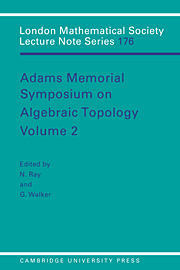Book contents
- Frontmatter
- Contents
- Preface
- Contents of Volume 1
- Programme of one-hour invited lectures
- Programme of contributed lectures
- Programme of Posters
- Participants in the Symposium
- Addresses of Contributors
- 1 Progress report on the telescope conjecture
- 2 On K*-local stable homotopy theory
- 3 Detruncating Morava K-theory
- 4 On the p-adic interpolation of stable homotopy groups
- 5 Some remarks on υ1 -periodic homotopy groups
- 6 The unstable Novikov spectral sequence for Sp(n), and the power series sinh−1(x)
- 7 Unstable Adams spectral sequence charts
- 8 On a certain localization of the stable homotopy of the space XΓ
- 9 Cooperations in elliptic homology
- 10 Completions of G-spectra at ideals of the Burnside ring
- 11 Theorems of Poisson, Euler and Bernouilli on the Adams spectral sequence
- 12 Algebras over the Steenrod algebra and finite H-spaces
- 13 The boundedness conjecture for the action of the Steenrod algebra on polynomials
- 14 Representations of the homology of BV and the Steenrod algebra I
- 15 Generic representation theory and Lannes' T-functor
- 16 Some chromatic phenomena in the homotopy of MSp
- 17 On a conjecture of Mahowald concerning bordism with singularities
- 18 Topological gravity and algebraic topology
16 - Some chromatic phenomena in the homotopy of MSp
Published online by Cambridge University Press: 18 January 2010
- Frontmatter
- Contents
- Preface
- Contents of Volume 1
- Programme of one-hour invited lectures
- Programme of contributed lectures
- Programme of Posters
- Participants in the Symposium
- Addresses of Contributors
- 1 Progress report on the telescope conjecture
- 2 On K*-local stable homotopy theory
- 3 Detruncating Morava K-theory
- 4 On the p-adic interpolation of stable homotopy groups
- 5 Some remarks on υ1 -periodic homotopy groups
- 6 The unstable Novikov spectral sequence for Sp(n), and the power series sinh−1(x)
- 7 Unstable Adams spectral sequence charts
- 8 On a certain localization of the stable homotopy of the space XΓ
- 9 Cooperations in elliptic homology
- 10 Completions of G-spectra at ideals of the Burnside ring
- 11 Theorems of Poisson, Euler and Bernouilli on the Adams spectral sequence
- 12 Algebras over the Steenrod algebra and finite H-spaces
- 13 The boundedness conjecture for the action of the Steenrod algebra on polynomials
- 14 Representations of the homology of BV and the Steenrod algebra I
- 15 Generic representation theory and Lannes' T-functor
- 16 Some chromatic phenomena in the homotopy of MSp
- 17 On a conjecture of Mahowald concerning bordism with singularities
- 18 Topological gravity and algebraic topology
Summary
Introduction.
In this paper, we derive formulae in Brown-Peterson homology at the prime 2 related to the family of elements φn ∈ MSp8n−3 of N. Ray, whose central rôle in the structure of MSp has been highlighted by recent work of V. Vershinin and other Russian topologists. In effect, we give explicit “chromatic” representatives for these elements, which were known to be detected in KO and mod 2 KU-homology, and are thus “υ1-periodic” in the parlance of [4] and [5]. In future work we will investigate further the υ1 periodic part of MSp and discuss the relationship of our work with that of B. Botvinnik.
I would like to thank Nigel Ray for many helpful discussions and large amounts of advice on MSp (including severe warnings!) over many years; in particular, §5 in this paper was prompted by his suggestions about the detection of jn in the classical Adams spectral sequence. I would also like to thank Boris Botvinnik, Vassily Gorbunov and Vladimir Vershinin for discussions on the material of earlier versions of this paper both during and after the J. F. Adams Memorial Symposium and in particular for bringing to my attention Buhstaber's article [2] which contains related results.
Some algebraic results onE*(MSp).
Let E be a commutative ring spectrum, and let xE ∈ E2(CP∞) be a complex orientation in the sense of [1]. Then the results of the following Theorem are well known.
- Type
- Chapter
- Information
- Adams Memorial Symposium on Algebraic Topology , pp. 263 - 280Publisher: Cambridge University PressPrint publication year: 1992
- 1
- Cited by



